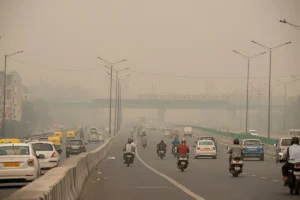The air quality in Delhi and its surrounding regions has deteriorated significantly, prompting the Commission for Air Quality Management (CAQM) to impose the most stringent measures under the Graded Response Action Plan (GRAP). As the air quality index (AQI) breached the “severe” category, Stage 4 restrictions have been enforced, including a complete ban on construction activities and the entry of non-essential goods trucks into the city.

GRAP, a dynamic plan designed to combat air pollution during winter months, categorizes air quality into four stages based on AQI levels. Stage 4, the most severe, necessitates drastic measures to curb emissions and protect public health. The decision to invoke Stage 4 comes as a result of consistently high pollution levels and unfavorable weather conditions that have trapped pollutants in the region.
Key Restrictions Under GRAP 4:
- Construction Ban: All construction and demolition activities, except for essential projects like linear public infrastructure (highways, roads, flyovers, etc.), have been halted.
- Truck Entry Ban: The entry of trucks carrying non-essential goods into Delhi has been prohibited.
- School Closures: Schools, except for classes 10 and 12, have been shifted to hybrid mode, with online classes being the primary mode of instruction.
- Staggered Timings: Public and municipal offices have been instructed to stagger their working hours to reduce traffic congestion and vehicular emissions.
- Vehicle Restrictions: The movement of BS-IV diesel and BS-III petrol vehicles has been restricted in Delhi-NCR.
The deteriorating air quality poses a significant health risk to the population, particularly vulnerable groups such as children and the elderly. Prolonged exposure to polluted air can lead to respiratory problems, heart diseases, and other serious health complications.
The CAQM has emphasized the need for strict compliance with the GRAP guidelines and has warned of further stringent measures if the air quality does not improve. The authorities have also appealed to the public to cooperate by minimizing the use of private vehicles, opting for public transport, and avoiding outdoor activities.
The Causes of Delhi’s Pollution Woes:
Delhi’s air pollution is a complex issue with multiple contributing factors:
- Vehicular Emissions: The high density of vehicles on Delhi’s roads, including a large number of diesel vehicles, contributes significantly to particulate matter and nitrogen oxide emissions.
- Industrial Pollution: Industries located in and around Delhi release harmful pollutants into the atmosphere, further exacerbating the problem.
- Construction Dust: Construction activities generate substantial amounts of dust, which can significantly impact air quality.
- Stubble Burning: The practice of stubble burning in neighboring states, particularly Punjab and Haryana, contributes to the influx of pollutants into Delhi during winter months.
- Meteorological Factors: Unfavorable weather conditions, such as calm winds and temperature inversions, trap pollutants in the atmosphere, leading to a sharp increase in pollution levels.
Combating Air Pollution: A Multi-pronged Approach:
Addressing Delhi’s air pollution requires a multi-pronged approach involving various stakeholders:
- Government Initiatives: The government needs to implement stricter emission norms for vehicles and industries, promote the use of public transport, and invest in cleaner energy sources.
- Technological Interventions: Technological advancements such as real-time air quality monitoring systems, pollution control devices for vehicles and industries, and green building technologies can play a crucial role in reducing pollution levels.
- Public Awareness and Participation: Raising public awareness about the harmful effects of air pollution and encouraging responsible behavior, such as minimizing vehicle use and opting for cleaner modes of transportation, is essential.
- Regional Cooperation: Collaboration between Delhi and neighboring states is crucial to address the issue of stubble burning and other regional factors contributing to air pollution.
Visit: Home Page